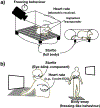Making translation work: Harmonizing cross-species methodology in the behavioural neuroscience of Pavlovian fear conditioning
- PMID: 31521698
- PMCID: PMC7822629
- DOI: 10.1016/j.neubiorev.2019.09.020
Making translation work: Harmonizing cross-species methodology in the behavioural neuroscience of Pavlovian fear conditioning
Abstract
Translational neuroscience bridges insights from specific mechanisms in rodents to complex functions in humans and is key to advance our general understanding of central nervous function. A prime example of translational research is the study of cross-species mechanisms that underlie responding to learned threats, by employing Pavlovian fear conditioning protocols in rodents and humans. Hitherto, evidence for (and critique of) these cross-species comparisons in fear conditioning research was based on theoretical viewpoints. Here, we provide a perspective to substantiate these theoretical concepts with empirical considerations of cross-species methodology. This meta-research perspective is expected to foster cross-species comparability and reproducibility to ultimately facilitate successful transfer of results from basic science into clinical applications.
Keywords: Associative learning; FPS; Fear conditioning; Fear extinction; Heat-rate; Human; Individual differences; Meta-research; Methods; Paradigm; Rodent; SCR; Startle; Translation; Treezing.
Copyright © 2019 The Authors. Published by Elsevier Ltd.. All rights reserved.
Figures


Similar articles
-
Tools for translational neuroscience: PTSD is associated with heightened fear responses using acoustic startle but not skin conductance measures.Depress Anxiety. 2011 Dec 21;28(12):1058-66. doi: 10.1002/da.20880. Epub 2011 Sep 2. Depress Anxiety. 2011. PMID: 21898707 Free PMC article.
-
Understanding Human Fear Extinction: Insights from Psychophysiology.Curr Top Behav Neurosci. 2023;64:59-77. doi: 10.1007/7854_2023_435. Curr Top Behav Neurosci. 2023. PMID: 37528308
-
Acoustic startle response in rats predicts inter-individual variation in fear extinction.Neurobiol Learn Mem. 2017 Mar;139:157-164. doi: 10.1016/j.nlm.2017.01.008. Epub 2017 Jan 25. Neurobiol Learn Mem. 2017. PMID: 28131759
-
Fear conditioning: Insights into learning, memory and extinction and its relevance to clinical disorders.Prog Neuropsychopharmacol Biol Psychiatry. 2025 Apr 2;138:111310. doi: 10.1016/j.pnpbp.2025.111310. Epub 2025 Mar 6. Prog Neuropsychopharmacol Biol Psychiatry. 2025. PMID: 40056965 Review.
-
The 'whole-animal approach' as a heuristic principle in neuroscience research.Biol Res. 2005;38(4):359-64. doi: 10.4067/s0716-97602005000400008. Biol Res. 2005. PMID: 16579518 Review.
Cited by
-
Oxytocin Promotes Accurate Fear Discrimination and Adaptive Defensive Behaviors.Front Neurosci. 2020 Sep 23;14:583878. doi: 10.3389/fnins.2020.583878. eCollection 2020. Front Neurosci. 2020. PMID: 33071751 Free PMC article. Review.
-
Cross-species neuroscience: closing the explanatory gap.Philos Trans R Soc Lond B Biol Sci. 2021 Jan 4;376(1815):20190633. doi: 10.1098/rstb.2019.0633. Epub 2020 Nov 16. Philos Trans R Soc Lond B Biol Sci. 2021. PMID: 33190601 Free PMC article.
-
Associative coding of conditioned fear in the thalamic nucleus reuniens in rodents and humans.Commun Biol. 2025 Aug 1;8(1):1142. doi: 10.1038/s42003-025-08580-0. Commun Biol. 2025. PMID: 40750836 Free PMC article.
-
Evidence of Altered Fear Extinction Learning in Individuals with High Vaccine Hesitancy During Covid-19 Pandemic.Clin Neuropsychiatry. 2023 Aug;20(4):364-369. doi: 10.36131/cnfioritieditore20230417. Clin Neuropsychiatry. 2023. PMID: 37791094 Free PMC article.
-
Studying the influence of single social interactions on approach and avoidance behavior: A multimodal investigation in immersive virtual reality.Behav Res Methods. 2025 Apr 25;57(6):157. doi: 10.3758/s13428-025-02627-0. Behav Res Methods. 2025. PMID: 40281351 Free PMC article.
References
Publication types
MeSH terms
Grants and funding
LinkOut - more resources
Full Text Sources
Miscellaneous

